One Month on and Outlets are bouncing back
With the reopening of non-essential retail just over a month ago, customers have been excitedly repopulating the nation’s shopping centres, high streets and outlets. It has brought back a sense of normality for many people – weary of Covid restrictions and the lack of human interaction that characterised the past year.
The hallowed reopening, paired with growing vaccination figures and falling Covid numbers, fostered real optimism for the retail industry. But the question on everyone’s lips is whether more visits to the shops actually translated into meaningful sales to boost the bottom line after the toughest trading period anyone can remember.
Widespread reporting of footfall spikes came in that first week back, but for many traditional shopping centres, that’s where their insight stopped. Outlets – with their longstanding turnover lease structure – offer much greater transparency, keeping the landlord firmly in the picture of the trading position of all its brand partners and primed to respond and support accordingly. This system allows us to dig deep into the specifics, uncovering the prevailing patterns from the past few weeks’ trade.
The first theme is that homeware has seen a steep, indeed unprecedented, rise having traditionally been a relatively minor retail category (accounting for barely 10% of total sales at a typical scheme). When compared with the same period in 2019, when Covid had yet to be coined, this category has delivered a massive sales increase of 57.9%. More time spent at home and a demand for fit-for-purpose home working provision is at play here but the impressive sales surge can also be explained by the “eat out drought”, forcing many to take time to learn to cook and equip themselves properly. Whether this will prompt a greater demand from homeware retailers for new stores remains to be seen – but this often overlooked category is certainly one to watch in H2 2021.
In other individual retail categories, we see a similar picture – sportswear and athleisure departments saw an increase of 39.5% against 2019, with some of Realm’s top anchor brands reporting ongoing bumper sales as gyms reopened. The athleisure fashion trend shows no sign of abating even after a year of wearing nothing but tracksuits and trainers, unbeknownst to colleagues on Teams calls!
With the gradual return of events, social engagements and moves towards returning to the office in June, on a part time basis at least, Realm has also seen signs of recovery to the womenswear, footwear and menswear categories throughout its portfolio. The outdoor category has also shot up 61% due to the increase in socialising outdoors and domestic travel being allowed, and as international travel looks to open up in the coming month, we expect this to only pick up pace.
What this pandemic has shown the industry, is the importance of landlords and tenants working in partnership to navigate the choppy waters of twenty-first century, pandemic-proof retailing and to manage stock replenishment more reactively so that opportunities are well and truly seized.
Collaboration, data-sharing and a shared business ambition with brand partners have long been central to Realm’s mantra as an outlet specialist. Our hope is that the wider retail industry will retain and build upon the dialogue and engagement that came out of Covid to keep sales, as well as footfall, healthy for everyone’s benefit, particularly as the retail industry accepts the inevitable shift to a turnover lease norm.
